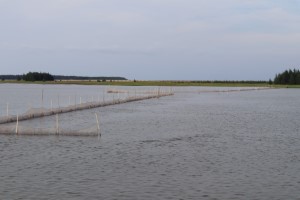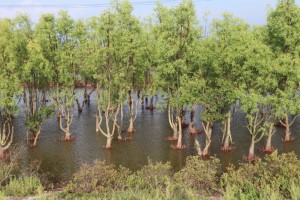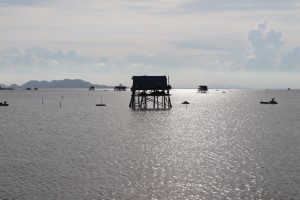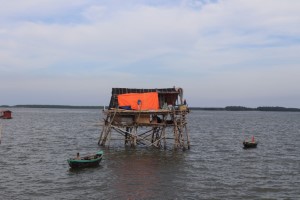In the far south east corner of Kim Son District lies a short stretch of coastal water abutting the large Gulf of Tonkin. Only 18 kilometers wide, this area is part of the extensive Red River Delta system, the delta area where the Day and Can River tributaries meet the sea.
This confluence of two large rivers has created a massive bay of mud and sand flats. Added to this, the shifting currents, tidal surges and alluvial deposits regularly change the underwater topology.
Locals call it the Floating Sea for the sand dunes that move around, both underwater and on the shorelines. Fringed by over 50 species of mangrove and fed by the large fresh water rivers, the bay is also less saline than the surrounding ocean.
Ecological Importance
The warm water, shallow seas and the profusion of mangroves have created a natural marine hatchery and breeding ground. Since UNESCO recognition, conservationists and local authorities have made considerable efforts to conserve and enhance this important watershed.
Long before scientists documented its ecological importance, natural forces formed a few small sand and clay atolls in the bay. The largest and most well-known of these is Con Noi (Noi Island). For millennia, this haven of bird and marine life was rarely visited by anyone bar local fishermen.
Historic Vision
The story is that in 2003, a local fisherman, Tran Van Thong, ran his vessel aground here. Stranded and waiting for the tide to change, he explored part of the 1000 hectare sanctuary. Returning home, he proposed a project to plant Casuarina (beach she oaks) and pine trees on the island. Such trees would help to protect the bay from the periodic typhoons which sweep through this part of the world. With such protection, his thought was to increase the aquaculture possibilities of the bay.
Con Noi Causeway
In less than twenty years, Tran Van Thong’s vision proved prophetic. Things have rapidly and dramatically changed for this once deserted island. After UNESCO granted accreditation, engineers constructed a spectacular 5km concrete and steel causeway to connect the island to the distant mainland.
Bear in mind that until that time, Con Noi was an uninhabited island wilderness in a remote and rarely visited part of the province. Even to this day, many Ninh Binh residents have yet to visit the island.
The causeway itself is reason enough to visit. The architectural and engineering feat of building such a long permanent access road across a wide bay of mud flats and shifting sands, is one thing. The sheer exhilaration of traveling across such a huge expanse of ocean, often with no other vehicles in sight, is indescribable.
You won’t face any danger on the well-constructed, smooth roadway. However, the sensation of speeding across the ocean, miles from land, creates a unique, thrilling and eerie experience that you shouldn’t miss.
Demonstrating Vietnamese ingenuity, technical skills, project management and sheer risk taking, the Xuan Truong Construction Enterprise along with the Ninh Binh Provincial Government have invested heavily. The vision is of a huge marine Eco-tourism precinct, with international hotels, temples, research centers and the construction of a permanent town on the island.
Con Noi Beach
Developers have already constructed a beach area by building a long breakwater on the eastern, ocean-facing side of the island. While it attracts a steady influx of local tourism, the beach itself is of brackish sand and the water somewhat cloudy. As such, few would rank it alongside places like Nha Trang, Mui Ne, Cát Bà, or Đà Nẵng. After all, mudflats and mangroves dominate the bay and play a vital role in supporting the region’s ecological diversity.
Which does not mean the effort has been wasted. As a marine research station, a fabulous bird sanctuary, a superb location for recreational fishing and a place of serene natural beauty, it has an attraction second to none.
Coming down from Phat Diem, the rice fields and palms gradually give way to massive fish farms. The startling contrast with the mountains and temples of Hoa Lư creates an estuary serenity that hides the massive effort people have made to transform this tangle of streams, rivers, and lakes into irrigation channels, dams, dykes, and safe river harbors.
From the causeway, visitors see an endless sea dotted with large “sentry” cabins (chòi canh) that stand on stilts over the water. These structures evidence the thriving aquaculture industry that Trần Văn Trọng once predicted. Looking like huge aquatic spiders, they are actually temporary living quarters to guard the precious oyster farms hidden below.
Travel Tips
Con Noi is around 45 km from Ninh Binh city and 24km from the spectacular Phat Diem Catholic Cathedral. As such it is a long way from most of the province’s major attractions. For this reason alone the area sees very little foreign tourism and you are guaranteed a unique experience. However, access is via self-drive, an expensive taxi ride or via custom tour operators. It is a long drive what ever option you choose. A truly a unique and special part of Ninh Binh and a far cry from the historic mountainous temples and palaces of a bygone age that the Province is renowned for. Well worth the visit if you have the time and interested in seeing a very different side of Ninh Binh.
One last tip – bring insect repellent and any refreshments you might need. If you are on a self-drive, make sure your vehicle is in good repair and has plenty of fuel. A the time of writing, shops and garages are few and far between once you get on the causeway.





